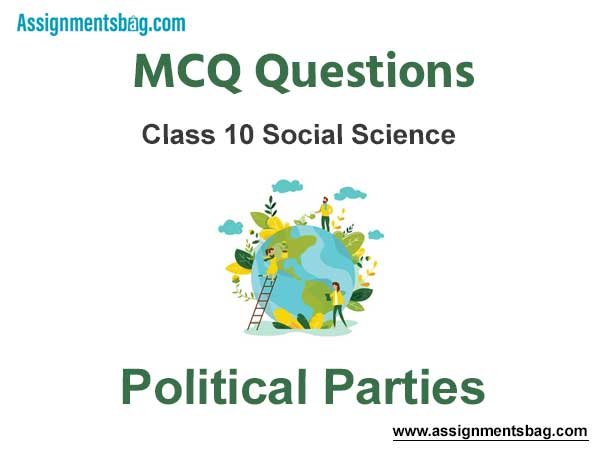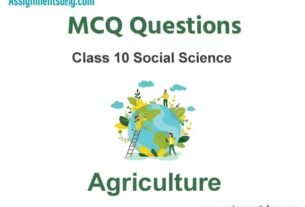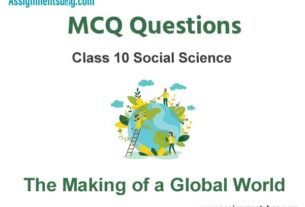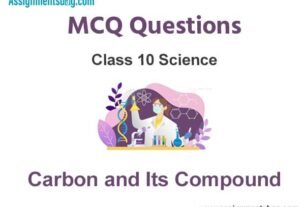Please refer to MCQ Questions Chapter 6 Political Parties Class 10 Social Science with answers provided below. These multiple-choice questions have been developed based on the latest NCERT book for class 10 Social Science issued for the current academic year. We have provided MCQ Questions for Class 10 Social Science for all chapters on our website. Students should learn the objective based questions for Chapter 6 Political Parties in Class 10 Social Science provided below to get more marks in exams.
Chapter 6 Political Parties MCQ Questions
Please refer to the following Chapter 6 Political Parties MCQ Questions Class 10 Social Science with solutions for all important topics in the chapter.
MCQ Questions Answers for Chapter 6 Political Parties Class 10 Social Science
Question. Which of the following political party was founded in 1998?
(a) All India Trinamool Congress
(b) Nationalist Congress Party
(c) Aam Admi Party
(d) Bharatiya Janata Party
Answer
A
Question. This party was founded in 1964 and believes in Marxism-Leninism. Identify the party:
(a) Communist Party of India
(b) Community Party of India
(c) Communist Party of India-Marxist
(d) None of these
Answer
C
Question. The rise of political parties can be linked directly to the emergenceof:
(a) Direct democracy
(b) Dictatorship
(c) Monarchy
(d) Representative democracy
Answer
D
Question. What does NDA stands for?
(a) Natural Democratic Alliance
(b) Nominative Democratic Alliance
(c) Nautical Democratic Alliance
(d) National Democratic Alliance
Answer
D
Question. In this party system, generally power changes between two main parties:
(a) Bi-party system
(b) Single party system
(c) Multi-party system
(d) None of these
Answer
A
Question. Which one of the following party systems is against the basic principle of democracy?
(a) Multi-party system
(b) Bi-party system
(c) Single party system
(d) None of the above
Answer
C
Question. Uniform civil code for all people living in the country irrespective of religion is the agenda of
(a) Indian National Congress
(b) Bharatiya Janata Party
(c) Nationalist Party of India
(d) Nationalist Congress Party
Answer
B
Question. Which of the following statements are not associated with a regional political party in India?
(a) It gets 6 percent of the total votes in the Lok Sabha election
(b) It gets 2 seats in the elections for state legislatures
(c) It gets 6 percent of the total votes in an election to the legislative assembly of a state
(d) All of these
Answer
A
Question. In India, which of the following alliance is NOT active?
(a) National Democratic Alliance
(b) United Progressive Alliance
(c) Left Front
(d) Right Front
Answer
D
Question. What does UPA stands for?
(a) United Party Alliance
(b) United Progressive Alliance
(c) Unified Political Alliance
(d) None of the above
Answer
B
Question. Which of the following institutions in India has passed an order for every candidate who contests elections to file an affidavit giving details of property and criminal cases?
(a) Supreme court of India
(b) Election Commission of India
(c) Constitution of India
(d) All of these
Answer
A
Question. Read the source given and answer the question below:
A political party is a group of people who come together to contest elections and hold power in the government. They agree on some policies and programmes for the society with a view to promote the collective good.
Which one of these is NOT a function of a political party?
(a) To reflect fundamental political divisions in a society.
(b) To contest elections.
(c) To play a decisive role in making laws.
(d) To form and run governments.
Answer
A
Question. Which of the following countries have biparty system?
(a) United Kingdom and Belgium
(b) United States of America and Canada
(c) United Kingdom and United States of America
(d) All of the above
Answer
C
Question. Which of the following political party draws inspiration from the ideas and teachings of Sahu Maharaj, Mahatma Phule,Ramaswamy Naicker and Dr Ambedkar?
(a) BJP
(b) BSP
(c) NCP
(d) CPI
Answer
B
Question. Arrange political parties according to their year of formation in increasing order:
(i) BSP
(ii) BJP
(iii) INC
(iv) CPI
Options:
(a) (i)—(iv)—(iii)—(ii)
(b) (iii)—(iv)—(i)—(ii)
(c) (iv)—(i)—(ii)—(iii)
(d) (iii)—(iv)—(ii)—(i)
Answer
A
Question. The election commission is the most visible institution of any Democracy. State whether the statement is True or False. If false, correct the statement.
Answer
False
Question. ……………….. is the oldest party of India.
Answer
Indian National Congress
Question. The ……………….. was leading the United Progressive Alliance (UPA) government from 2004 to 2014.
Answer
Indian National Congress
Question. ……………….. was the last party to become a national level party in India.
Answer
All India Trinamool Congress
Question. Any democratic system must allow at least …………………. parties to contest elections to provide fair chances.
Answer
Two or more
Question. The body which recognizes and registers Political Parties in India is called …………………
Answer
Election Commission
Question. The Bharatiya Janta Party came into power in 1998 as the leader of the ……………….. coalition.
Answer
NDA
Question. ……………….. is a National Political Party in India formed in 1984 by late Kanshi Ram.
Answer
Bahujan Samaj party
Question. Complete the following table with regards to information about political parties:
Answer
(A) 4
(B) 2
Question. Read the passage given below and answer the question that follows:
Only a handful ofparties are effectively in the race to win elections and form the government. So the question, then is: how many major or effective Parties are good for a democracy? In some countries, only one party is allowed to control and run the government. These are called one-party systems. China is one such country.
Based on your reading, complete the following statement:
The ……………….. is the only political party that is allowed to function in China.
Answer
The Chinese communist party
Question. In which year did the Communist Party of India split into two parties?
Answer
1964
Question. Which type of government is formed when two or more political parties come together to form a government?
Answer
Coalition Government
Question. Read the source given below and answer the question that follow:
Formed in 1999 following a split in the Congress party. Espouses democracy, Gandhian secularism, equity, social justice and federalism. Wants that high offices in government be confined to natural born citizens of the country.
Identify this political party.
Answer
Nationalist Congress party
Match the Columns
Question. Match the following political parties from column A with their years of foundation given in column B:
| Column A (Political Parties) | Column B (Year of Foundation) |
| (a) Communist Party of India | (i) 1885 |
| (b) Bharatiya Janata Party | (ii) 1984 |
| (c) Bahujan Samaj Party | (iii) 1980 |
| (d) Indian National Congress | (iv) 1925 |
Answer :
| Column A (Political Parties) | Column B (Year of Foundation) |
| (a) Communist Party of India | (iv) 1925 |
| (b) Bharatiya Janata Party | (iii) 1980 |
| (c) Bahujan Samaj Party | (ii) 1984 |
| (d) Indian National Congress | (i) 1885 |
Question. Match the following political parties from column A with their ideologies given in column B:
| Column A (Political Parties) | Column B (Ideologies) |
| (a) Bharatiya Janata Party | (i) Believes in Marxism-Leninism |
| (b) Bahujan Samaj Party | (ii) supports new economic reforms with a human face |
| (c) Indian National Congress | (iii) Seeks to represent and secure power for the Bahujan Samaj |
| (d) Communist Party of India | (iv) Uniform civil code |
Answer :
| Column A (Political Parties) | Column B (Ideologies) |
| (a) Bharatiya Janata Party | (iv) Uniform civil code |
| (b) Bahujan Samaj Party | (iii) Seeks to represent and secure power for the Bahujan Samaj |
| (c) Indian National Congress | (ii) supports new economic reforms with a human face |
| (d) Communist Party of India | (i) Believes in Marxism-Leninism |
Question. Match List I (organigations and struggles) with List II and select the correct answer using the codes given below the lists :
| List I | List II |
| (i) Congress Party | (a) National Democratic Alliance |
| (ii) Bharatiya Janata Party | (b) State Party |
| (iii) Communist Party of India (Marxist) | (c) United Progressive Alliance |
| (iv) Telugu Desam Party | (d) Left Front |
(A) (i)-(c), (ii)-(a), (iii)-(b), (iv)-(d)
(B) (i)-(c), (ii)-(d), (iii)-(a), (iv)-(b)
(C) (i)-(c), (ii)-(a), (iii)-(d), (iv)-(b)
(D) (i)-(d), (ii)-(c), (iii)-(a), (iv)-(b)
Answer
C

We hope you liked the above provided MCQ Questions Chapter 6 Political Parties Class 10 Social Science with solutions. If you have any questions please ask us in the comments box below.


